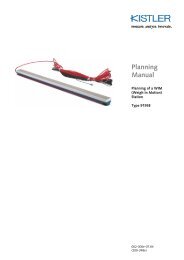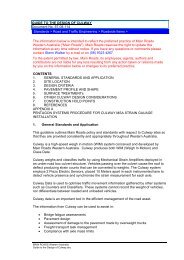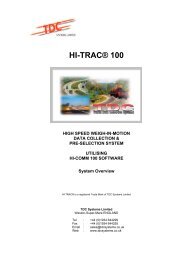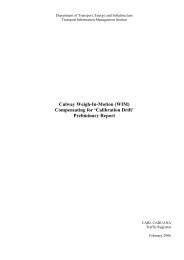AP-G84/04 Best practice in road use data collection, analysis ... - WIM
AP-G84/04 Best practice in road use data collection, analysis ... - WIM
AP-G84/04 Best practice in road use data collection, analysis ... - WIM
You also want an ePaper? Increase the reach of your titles
YUMPU automatically turns print PDFs into web optimized ePapers that Google loves.
Accessed by AR - ARRB TRANSPORT RESEARCH on <strong>04</strong> Feb 2005<br />
Aust<strong>road</strong>s 20<strong>04</strong><br />
— 5 —<br />
<strong>Best</strong> Practices <strong>in</strong> Road Use Data Collection, Analysis and Report<strong>in</strong>g<br />
The ability to detect gaps between adjacent vehicles and obta<strong>in</strong> a valid vehicle count is dependent<br />
on the length of the <strong>in</strong>ductive loop <strong>in</strong> the direction of travel along a lane. Undercount<strong>in</strong>g will occur<br />
when the loop detection zone is too long.<br />
Mendigor<strong>in</strong> et al. (2003) described studies <strong>in</strong> Sydney on us<strong>in</strong>g axle sensors for classified counts <strong>in</strong><br />
urban traffic. Their results suggested that a separation of 4 m between two axle sensors provide<br />
good accuracy and these results are consistent with those obta<strong>in</strong>ed <strong>in</strong> Luk and Besley (1985) us<strong>in</strong>g<br />
different count<strong>in</strong>g equipment. The optimal separation is a balance between equipment accuracy<br />
and fluctuations of vehicle speeds between the two axle sensors. It is dependent on the type of<br />
equipment and the associated software <strong>use</strong>d <strong>in</strong> a study.<br />
T 1<br />
T 3<br />
T 2<br />
T 4<br />
Pair of axle<br />
sensors<br />
Vehicle actuation<br />
pulses<br />
T 1<br />
Figure 2 – Four positions of a two-axle vehicle pass<strong>in</strong>g over two axle sensors<br />
In summary, a pair of axle sensors should be considered where possible to give better accuracy,<br />
better dist<strong>in</strong>ction by direction, and the ability to produce classified counts through axle<br />
configurations. If a s<strong>in</strong>gle axle is <strong>use</strong>d, it is a recommended <strong>practice</strong> to correct for traffic<br />
composition and convert axle-pairs <strong>in</strong>to vehicle counts for report<strong>in</strong>g purposes.<br />
3.2 Inductive Loop Sensor and Vehicle Counts<br />
The operation of a loop sensor requires an alternat<strong>in</strong>g current pass<strong>in</strong>g through the <strong>in</strong>ductive loop.<br />
When a mass of metal such as a vehicle chassis and an eng<strong>in</strong>e passes through the<br />
electromagnetic field of the loop, the <strong>in</strong>ductance of the loop reduces. These reductions are <strong>use</strong>d to<br />
<strong>in</strong>dicate the passage or presence of a vehicle.<br />
Figure 3 shows the typical response of a loop detector when crossed by a passenger car. The<br />
reduction <strong>in</strong> loop <strong>in</strong>ductance depends on the size and metallic content of the vehicle. For example,<br />
a passenger car generates a change of about five per cent for the loops typically <strong>use</strong>d <strong>in</strong> traffic<br />
count<strong>in</strong>g. The <strong>in</strong>ductive loop detector is <strong>use</strong>d extensively for automatic traffic count<strong>in</strong>g, traffic<br />
surveillance and traffic signal control. The <strong>analysis</strong> of <strong>in</strong>ductive loop profiles can also be <strong>use</strong>d for<br />
vehicle classification but is seldom <strong>use</strong>d amongst RAs.<br />
−<br />
T 13<br />
T 3<br />
−<br />
T 2<br />
−<br />
T 34<br />
T 4<br />
−<br />
Time

















